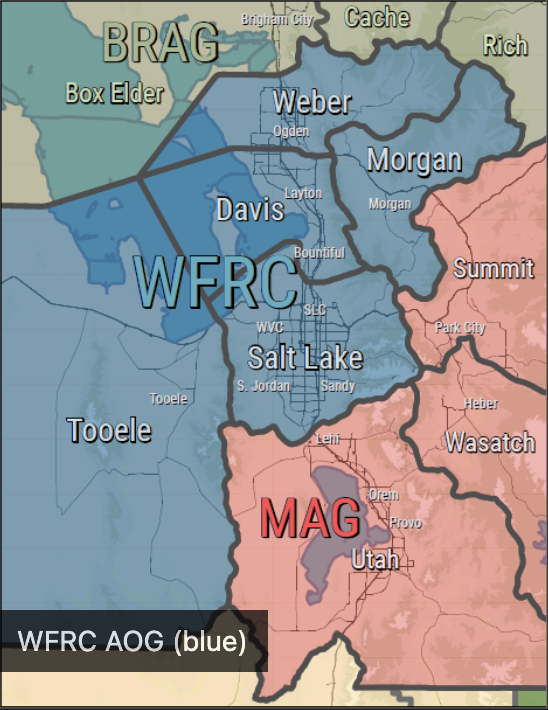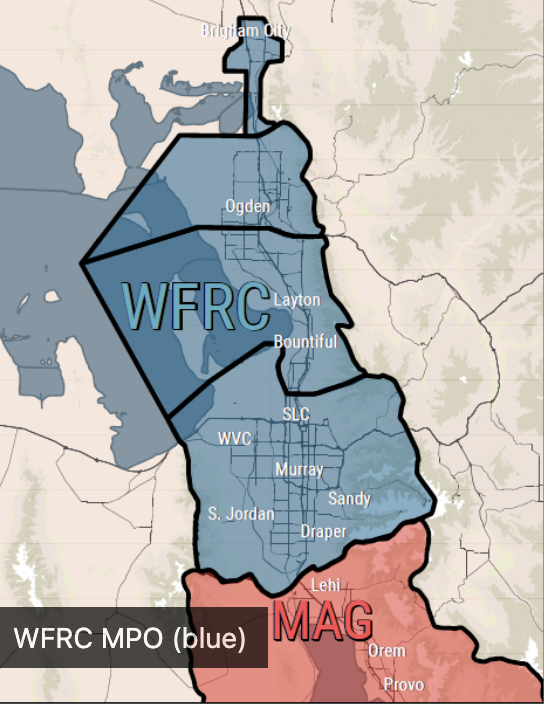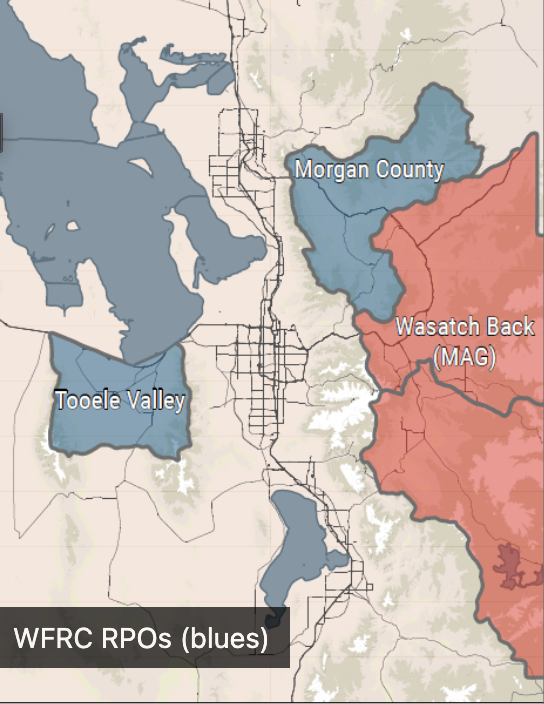Now is your chance to shape the outcome of proposed transportation projects affecting the Wasatch Front. Read our blog below to learn more about the Wasatch Front Regional Council’s 2025-2030 Transportation Improvement Program (TIP). Don’t wait, submit a comment today to directly participate in implementing more sustainable, equitable transportation options to the Wasatch Mountains! Our blog contains sample language to help you write your comment, too!
What is the Wasatch Front Regional Council (WFRC) and why should you send a comment before August 3rd?
Transportation planning in the Wasatch Mountains is a cooperative effort of federal, state, and local agencies. The Wasatch Front Regional Council (WFRC) is responsible for coordinating this transportation planning process as the designated Metropolitan Planning Organization (MPO) for the Wasatch Front.



The Wasatch Front Regional Council’s Service Area, pictured above. Also pictured are service areas for the Mountainland Association of Governments and the Cache MPO.
Supporters of Save Our Canyons will remember - last year, we organized at the WFRC meeting where the proposed Gondola in Little Cottonwood Canyon was added to WFRC’s Regional Transportation Plan. Many of you were there in person, and thousands submitted comments and tuned in online to demonstrate their opposition to the Gondola. While the proposed Gondola has not been included in the 2025-2030 Transportation Improvement Program, it’s critical we continue to advocate for lower-impact solutions to congestion, like bussing and congestion-based tolling, which are included in the 2025-2030 TIP, as a way of proactively preventing the Gondola, so that low impact solutions have the opportunity to be implemented and funded before a Gondola plan is ever realized. To be clear, the Gondola is still included as a project in the WFRC’s long range planning process (the Regional Transportation Plan), but because the TIP is a function of short-range planning, and gondola implementation is expected around 2040 (outside of the TIP's range of planning), the Gondola is too far from implementation to consider at this point.
What is the difference between the WFRC’s Regional Transportation Plan and the Transportation Improvement Program?
The Wasatch Front Regional Council's Regional Transportation Plan (RTP) is a long-term strategy that outlines transportation projects and goals for the region over a 20 to 30-year period. It addresses future transportation needs and prioritizes projects based on anticipated growth, land use, and economic trends. In contrast, the Transportation Improvement Program (TIP) is a short-term plan that lists specific projects to be implemented over the next four years. The TIP is essentially an actionable subset of the RTP, detailing the projects that have secured funding and are ready for construction or development. While the RTP focuses on strategic, big-picture planning, the TIP provides a more immediate, tactical approach to achieving those goals. The RTP is a long-range planning tool, where the TIP is a short-range plan to enact the larger goals laid out in the RTP.
Where should I submit a comment to the WFRC’s comment period?
You are invited to comment on individual projects proposed in the TIP, either on WFRC’s story map, located here.
Or through WFRC’s general comment form, located here.
What should I say in my comment?
We encourage you to personalize your comments and offer project specific comments. Please feel free to use the following short comment from Save Our Canyons as a baseline, but comments which are exact copies will only be considered as one comment by the WFRC. It advocates for implementation of enhanced bus service in Big and Little Cottonwood Canyons and congestion-based tolling, ensuring equitable access and preventing overuse by incentivizing tolling.
Suggested comment:
“Dear Wasatch Front Regional Council Short-Range Planning Team,
Thank you for the opportunity to comment on the Draft 2025-2030 Transportation Improvement Program (TIP). As an advocate for the Wasatch Mountains, I support the implementation of enhanced bus service and congestion-based tolling in both Big and Little Cottonwood Canyons, ensuring equitable access and preventing overuse by incentivizing tolling. I urge that the $150 million from the Legislature and $42 million from the Recreational Hot Spots Program be strictly allocated to projects identified in phases 1 and 2 of the LCC EIS process, such as bussing, tolling, and mobility hubs, as outlined in the TIP. Metrics for success should be established for these projects to ensure accountability and guide future phases. Transparency with the public about these metrics is crucial for fostering trust and achieving the desired transportation improvements.”
Still want to know more about the process? Read Save Our Canyons long form comment here, for inspiration!

